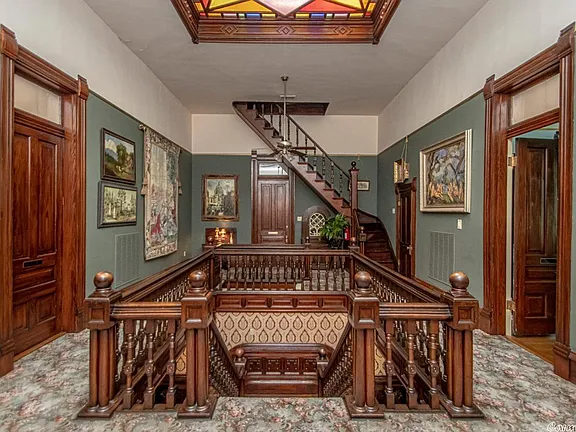1840-1880
Gothic Revival
Stone, Spires, and Sophistication: The Charm of Gothic Revival
The Gothic Revival architectural style emerged as a distinct trend in American home design from the mid-19th century. It was especially favored by the wealthy and educated classes, who sought to emulate the grandeur and sophistication of medieval European architecture.
In the decades leading up to the Civil War, the popularity of Gothic Revival soared, particularly in the Northeast, where its intricate stone masonry complemented the region’s rugged natural landscape. New York’s Hudson River Valley and the surrounding areas became a hotbed for the Gothic Revival movement, with iconic estates such as Lyndhurst standing testament to its appeal.
In contrast to the symmetrical designs of Greek Revival architecture, Gothic Revival homes are characterized by their asymmetry and vertical emphasis. Their facades are often adorned with intricate stone or wood carvings, featuring arches, spires, and pinnacles that echo the grandeur of medieval cathedrals.
Despite the disruptions of the Civil War and the changing tastes that followed, Gothic Revival continued to influence American architecture well into the late 19th century. In more remote areas, where stone was not readily available, Carpenter Gothic homes – characterized by their elaborate wooden ornamentation – became an accessible interpretation of this grand style.
The Gothic Revival style emerged as a counterpoint to the Classical styles that had dominated the architectural landscape. This architectural movement drew inspiration from the Middle Ages, a period that was seen as a stark contrast to the age of reason embodied by the Classical era. Gothic Revival was not just an architectural style; it represented a broader cultural movement that embraced romantic literature, medieval history, and spiritual values.
Gothic Revival became especially prevalent in the design of academic institutions, religious buildings, and other public edifices, mirroring the style’s origins in the great cathedrals of Europe. The University of Chicago and the Smithsonian Institution in Washington, D.C. are prime examples of the application of Gothic Revival in the public and educational realm. The style’s ecclesiastical associations made it a favored choice for churches and cathedrals, with New York’s Trinity Church and St. Patrick’s Cathedral standing as iconic examples.
The reach of Gothic Revival was not limited to urban settings. The style was readily adopted in the countryside, particularly for the construction of grand country estates. Biltmore Estate in North Carolina, for instance, is a prime example of a Gothic Revival country house. It’s also worth noting that Gothic Revival was not exclusive to the affluent; the style was also adapted to more modest residential buildings, demonstrating the versatility and wide appeal of the style.
The Gothic Revival movement also had a significant influence on interior design, promoting an aesthetic that favored dark, rich colors, heavy furniture, and ornate detailing. The style often incorporated features such as pointed arch windows, steeply pitched roofs, and decorative tracery, all of which were reminiscent of medieval Gothic architecture. The revival of this historical style marked a significant shift in American architecture, moving away from the classical order and symmetry towards a more romantic, dramatic aesthetic.
Historic Elegance at Your Fingertips: Plan a stay in a beautiful home.


What about the interior?
The design of Gothic Revival interiors closely aligns with the majestic medieval ambiance of the exteriors. A key feature of this design style is the heightened ceilings, often vaulted, that contribute to the distinctive sense of verticality associated with Gothic Revival.
Gothic arches, another defining feature, are a frequent sight, gracing doorways, windows, and even integrated into the design of built-in cabinetry. This repetitive use of a single architectural element ensures a consistent Gothic aesthetic permeates the entire home.
Inside these homes, the use of decorative woodwork is generous. Intricate carvings adorn moldings and cornices, and wood paneling frequently dresses both walls and ceilings. Fireplaces, a prominent fixture in the living spaces, often boast elaborately carved mantels, reinforcing the grandeur inherent in this architectural style.
Despite their visual splendor, Gothic Revival homes place a strong emphasis on comfort and habitability. Both the dining room and kitchen areas are designed to be spacious, accommodating social gatherings in alignment with the medieval tradition of hospitality.
